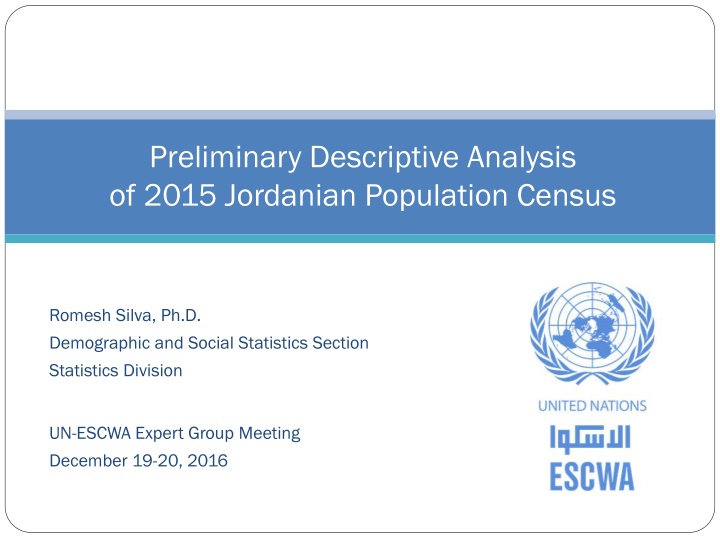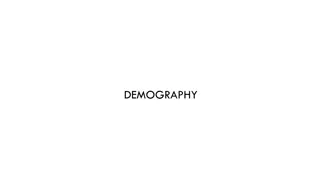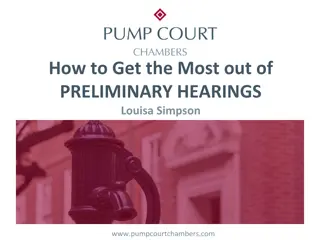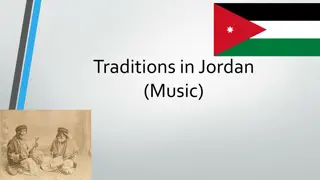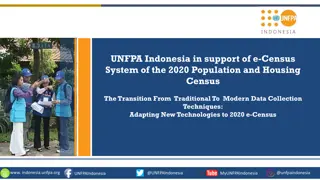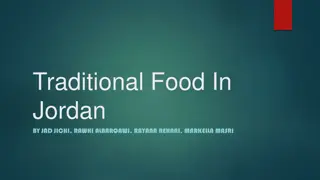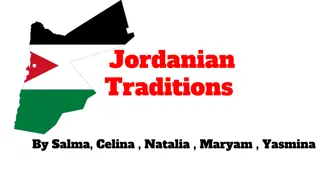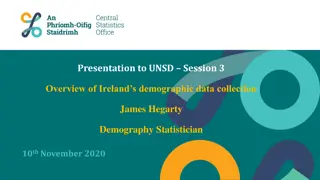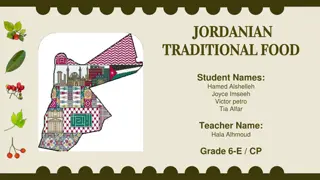Preliminary Descriptive Analysis of 2015 Jordanian Population Census
This analysis presents insights on Syrian refugees in Jordan based on the 2015 census data, covering population size, structure, composition, migration patterns, mortality outcomes, age/sex distribution, household characteristics, asylum status, and self-reported refugee registration status. Limitations related to household deaths data are also discussed.
Download Presentation

Please find below an Image/Link to download the presentation.
The content on the website is provided AS IS for your information and personal use only. It may not be sold, licensed, or shared on other websites without obtaining consent from the author.If you encounter any issues during the download, it is possible that the publisher has removed the file from their server.
You are allowed to download the files provided on this website for personal or commercial use, subject to the condition that they are used lawfully. All files are the property of their respective owners.
The content on the website is provided AS IS for your information and personal use only. It may not be sold, licensed, or shared on other websites without obtaining consent from the author.
E N D
Presentation Transcript
Preliminary Descriptive Analysis of 2015 Jordanian Population Census Romesh Silva, Ph.D. Demographic and Social Statistics Section Statistics Division UN-ESCWA Expert Group Meeting December 19-20, 2016
Outline What can we learn about Syrian refugees from the Jordanian Census regarding: population size, structure, composition , migration patterns, and, mortality outcomes of Syrian refugees in Jordan? 1. 2. 3. 2
Age/Sex Distribution of Nationals & Refugees, 2015 Jordanian Population Census N=1.305 million N=6.579million 3
Sex & Dependency Ratios for Nationals & Refugees, 2015 Sex Ratio (Males per 1000 Females) 4 Age
Household Size by Sex Household Size by Sex of Head of Household of Head of Household for Refugee and for Refugee and Jordanian Households, Jordanian Households, 2015 2015 5 Household Size Household Size
Asylum Status Questions included in 2015 Jordanian Population Census 6
Self-reported refugee registration status by country of origin and sex, Jordan 2015 % Share of Refugee Population by Country of Origin: Syria 43.4 Palestine 21.7 Egypt 21.8 Other 13.1 7
Household Deaths (in previous 24 months) Household Deaths (in previous 24 months) Question in Population Census Question in Population Census 8
Limitations of HH Deaths Data from Census Census data on household deaths are however associated with a number of limitations that are likely to bias mortality estimates derived from them: Survival Selection Bias: the process of collecting data on deaths within households selectively captures only certain types of deaths that occurred in the year preceding the census. deaths that lead to the disintegration of households, such as deaths in single person households, are more likely to be underreported (Timaeus 1991, Stanton et al 2001). Age reporting is sometimes inaccurate for both the population of the deceased and the enumerated population. In the case of the latter, accurate age reporting is important because the enumerated population is used to generate the denominators used in all three death distribution methods in their assessment of estimated completeness of deaths relative to population counts. Time-reference errors associated with the inability of respondents to locate household deaths within the specified reference period, and Disclosure bias/errors associated with the reluctance of respondents to talk about the dead (Timaeus, 1991). 1. 2. 3. 4. 9
Indirect Methods to Estimate DR Completeness and Adult Mortality 1. Preston-Coale Method makes use of the observation that the number of people of a given age alive at a point in time must be equal to the number of people from that cohort who die from that point in time onward. It is thus possible to estimate the current population aged y using only current deaths by age above age y and the stable growth rate r. 2. Brass Growth Balance Method Makes use of the observation that in a stable population (i.e. a population with an unchanging age structure over time at least for the adult ages growing at a constant rate, r, each year) that is closed to migration and has accurately reported data, the growth rate, r, is equal to the birth rate, b, less the death rate, d. A similar relationship holds for the population aged x and older, 10
Assumptions of Indirect Methods Assumptions of Preston-Coale Method: constant completeness of coverage of the censuses and reporting of deaths by age net migration over the 2-year period prior to the census has been small in scale, and no major distortions of age reporting between five-year age groups Assumptions of Brass Growth Balance Method: population is stable (although this assumption can be relaxed to some extent). completeness of reporting of deaths is the same for all ages above a minimum age (usually age 15). Population is closed to migration, although this assumption can be relaxed if net migration is small relative to the mortality rates, or if one has reasonably accurate estimates of the number of migrants by age to allow for in the balance equation (which is very seldom the case). 11
Growth Balance Diagnostic Results: Non-Jordanian Males Residuals 0.140 0.120 0.020 TABLE HERE 0.100 0.015 b(x+) 0.010 0.080 0.005 0.060 0.000 0.000 0.002 0.004 0.006 0.008 0.010 0.012 0.014 0.016 0.018 0.040 -0.005 -0.010 0.020 -0.015 0.000 -0.020 0.000 0.002 0.004 0.006 0.008 0.010 0.012 0.014 0.016 0.018 -0.025 d(x+) -0.030 Obs Fitted Assumptions violated! 0.16 2.00 1.50 0.14 1.00 0.12 0.50 0.00 0.10 -0.50 Y(x) 5mx 0.08 -1.00 Smoothed adjusted rates -1.50 0.06 -2.00 Observed adjusted rates 0.04 -2.50 0.02 -3.00 -3.00 -2.00 -1.00 0.00 Ys(x) Obs. Y(x) 1.00 2.00 3.00 0.00 13 0 20 40 60 80
Possible Next Steps Relax negligible migration assumption, by utilizing migration information from the 2015 population census Obtain tabulations of death registration data from MoI (Jordan) to compare with reported recent births/deaths in Population Census Data Integration / Record Linkage 14
Dual Systems Estimation A = vital events recorded in the vital registration system B = enumerated births/deaths in 2015 population census M = total vital (birth/death) events 15
Record Linkage and Dual Systems Estimation Method: Technique 16
Record Linkage and Dual Systems Estimation Method: Assumptions 1. Error-free matching of vital events Use of semi-automated matching that draws on machine- learning techniques 2. Homogeneity of capture of vital events within each data system (e.g. CR system, Census HH Deaths data, etc.) Stratification by key variables (sex, ethnicity, governorate) prior to matching 3. Independence of the data systems (i.e. inclusion in one dataset is not dependent on inclusion of the second data source) Use more than 2 sources examples from Brazil, Thailand, 4. Negligible in/out-migration (or available migration data or plausible migration model) 17
Potential of Data Integration and Record Linkage for systems assessment/improvement Szwarcwald et al. (2014) used proactive search process of vital events in North/Northeast Brazil to identify: live birth and death certificates issued but not reported to the CRVS system, and live births and deaths whose certificates were not issued. Use of multiple alternative data sources! recognition of the largely passive nature of civil registration procedures 18
Potential of Data Integration and Record Linkage for systems assessment/improvement What are the possibilities and analogs in refugee settings? Record Linkage with: UNHCR ProGres Database Annual Vulnerability Assessment on Syria (VASYR) Surveys Official vital registration records Ad-hoc household surveys Health Facility Records etc. 19
